Corporation & Enterprise Law: In-Depth Case Study and Legal Analysis
VerifiedAdded on 2022/09/15
|9
|1903
|12
Case Study
AI Summary
This document presents a comprehensive case study analysis focusing on Corporation and Enterprise Law, specifically addressing contract law principles. The analysis dissects three distinct case studies, each presenting unique legal issues. The first case explores the formation of a binding contract, examining the elements of offer, acceptance, consideration, and intention to create legal relations within a commercial context. The second case delves into domestic agreements, assessing the enforceability of an agreement between separated parties. The final case scrutinizes the concept of undue influence, evaluating the validity of acceptance under duress and the potential arguments a party can raise. Each case study includes an issue statement, legal rules, application of those rules to the facts, and a final conclusion. The document references key legal precedents such as Fisher v Bell, Balfour v Balfour, and Barclays Bank v O'Brien, demonstrating a solid understanding of contract law and legal reasoning.

Corporation &
Enterprise Law
Running head: “Corporation & Enterprise Law” 0
Student’s Name
Address
Enterprise Law
Running head: “Corporation & Enterprise Law” 0
Student’s Name
Address
Paraphrase This Document
Need a fresh take? Get an instant paraphrase of this document with our AI Paraphraser
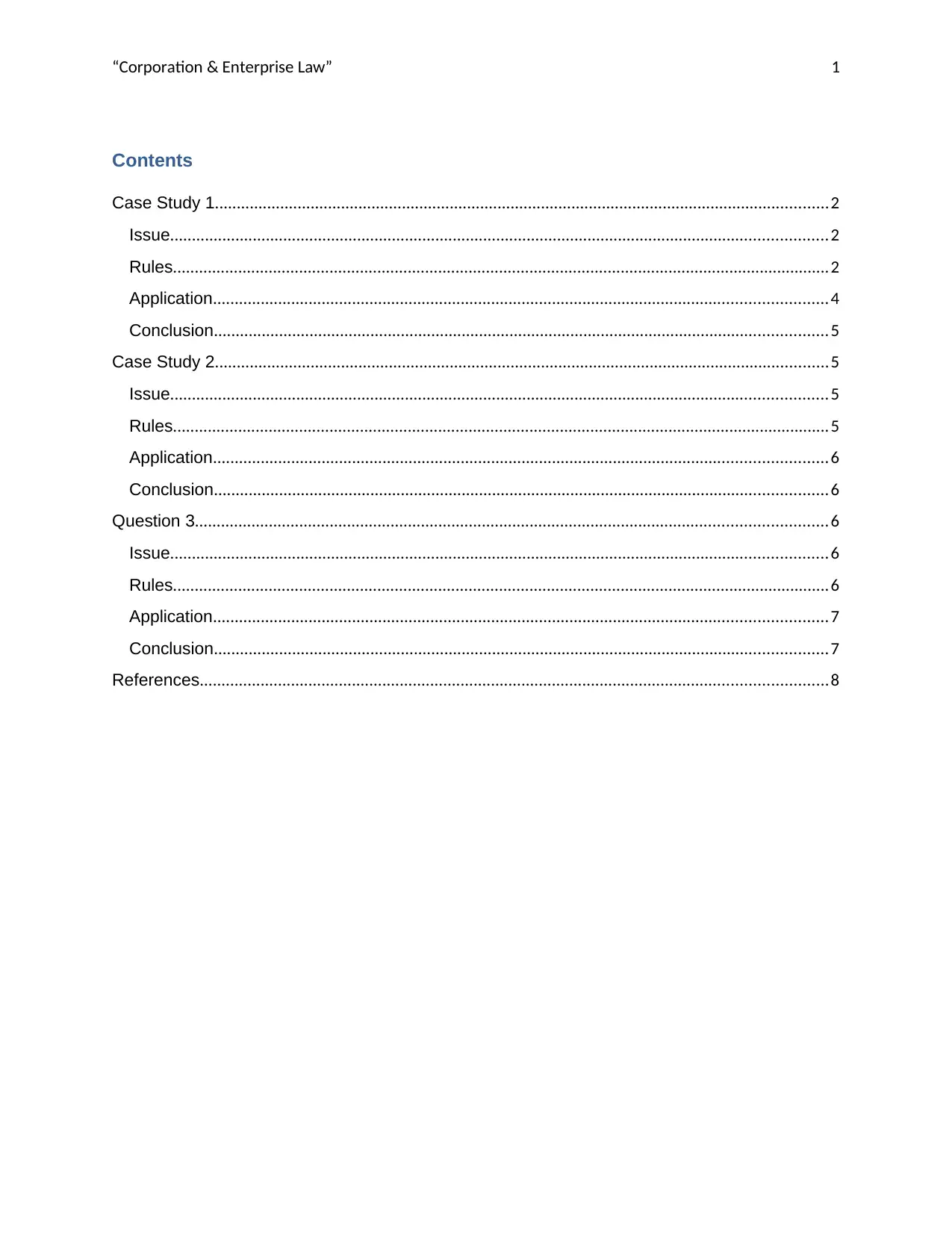
“Corporation & Enterprise Law” 1
Contents
Case Study 1.............................................................................................................................................2
Issue.......................................................................................................................................................2
Rules.......................................................................................................................................................2
Application.............................................................................................................................................4
Conclusion.............................................................................................................................................5
Case Study 2.............................................................................................................................................5
Issue.......................................................................................................................................................5
Rules.......................................................................................................................................................5
Application.............................................................................................................................................6
Conclusion.............................................................................................................................................6
Question 3.................................................................................................................................................6
Issue.......................................................................................................................................................6
Rules.......................................................................................................................................................6
Application.............................................................................................................................................7
Conclusion.............................................................................................................................................7
References................................................................................................................................................8
Contents
Case Study 1.............................................................................................................................................2
Issue.......................................................................................................................................................2
Rules.......................................................................................................................................................2
Application.............................................................................................................................................4
Conclusion.............................................................................................................................................5
Case Study 2.............................................................................................................................................5
Issue.......................................................................................................................................................5
Rules.......................................................................................................................................................5
Application.............................................................................................................................................6
Conclusion.............................................................................................................................................6
Question 3.................................................................................................................................................6
Issue.......................................................................................................................................................6
Rules.......................................................................................................................................................6
Application.............................................................................................................................................7
Conclusion.............................................................................................................................................7
References................................................................................................................................................8
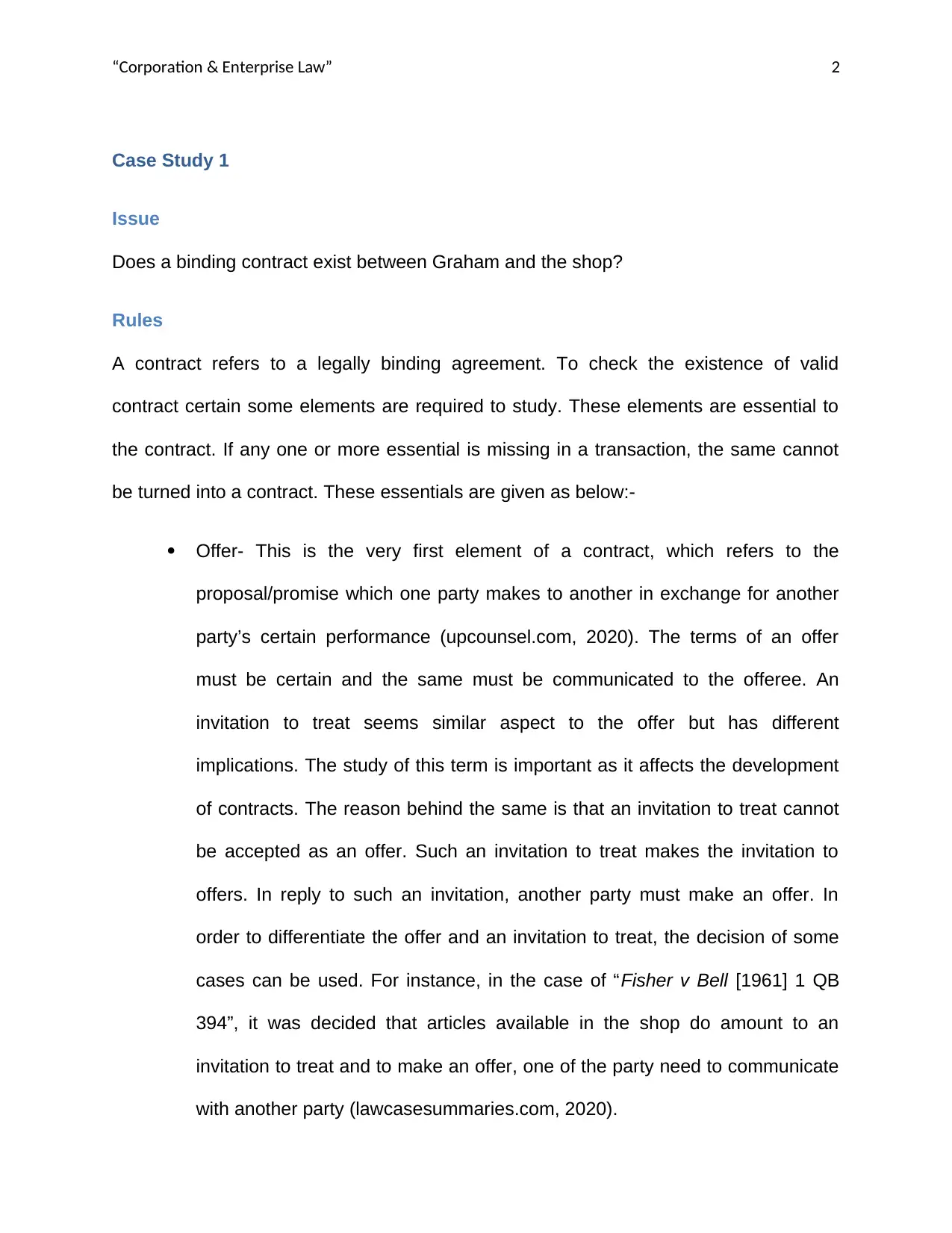
“Corporation & Enterprise Law” 2
Case Study 1
Issue
Does a binding contract exist between Graham and the shop?
Rules
A contract refers to a legally binding agreement. To check the existence of valid
contract certain some elements are required to study. These elements are essential to
the contract. If any one or more essential is missing in a transaction, the same cannot
be turned into a contract. These essentials are given as below:-
Offer- This is the very first element of a contract, which refers to the
proposal/promise which one party makes to another in exchange for another
party’s certain performance (upcounsel.com, 2020). The terms of an offer
must be certain and the same must be communicated to the offeree. An
invitation to treat seems similar aspect to the offer but has different
implications. The study of this term is important as it affects the development
of contracts. The reason behind the same is that an invitation to treat cannot
be accepted as an offer. Such an invitation to treat makes the invitation to
offers. In reply to such an invitation, another party must make an offer. In
order to differentiate the offer and an invitation to treat, the decision of some
cases can be used. For instance, in the case of “Fisher v Bell [1961] 1 QB
394”, it was decided that articles available in the shop do amount to an
invitation to treat and to make an offer, one of the party need to communicate
with another party (lawcasesummaries.com, 2020).
Case Study 1
Issue
Does a binding contract exist between Graham and the shop?
Rules
A contract refers to a legally binding agreement. To check the existence of valid
contract certain some elements are required to study. These elements are essential to
the contract. If any one or more essential is missing in a transaction, the same cannot
be turned into a contract. These essentials are given as below:-
Offer- This is the very first element of a contract, which refers to the
proposal/promise which one party makes to another in exchange for another
party’s certain performance (upcounsel.com, 2020). The terms of an offer
must be certain and the same must be communicated to the offeree. An
invitation to treat seems similar aspect to the offer but has different
implications. The study of this term is important as it affects the development
of contracts. The reason behind the same is that an invitation to treat cannot
be accepted as an offer. Such an invitation to treat makes the invitation to
offers. In reply to such an invitation, another party must make an offer. In
order to differentiate the offer and an invitation to treat, the decision of some
cases can be used. For instance, in the case of “Fisher v Bell [1961] 1 QB
394”, it was decided that articles available in the shop do amount to an
invitation to treat and to make an offer, one of the party need to communicate
with another party (lawcasesummaries.com, 2020).
⊘ This is a preview!⊘
Do you want full access?
Subscribe today to unlock all pages.

Trusted by 1+ million students worldwide

“Corporation & Enterprise Law” 3
Acceptance: At the receipt of an offer, the offeree has two options such as
either to accept or to reject the offer. To form an agreement and a valid
contract further, the offeree needs to accept the received offer. This
acceptance must be absolute without any changes in the terms of the original
offer. The decision of the case titled Felthouse v Bindley EWHC CP J 35,
given that silence of offeree cannot be treated as acceptance of the parties
(McKendrick and Liu, 2015).
The intention of the parties:- This essential of the contract aims to sort out
those agreements where parties do not have any intention to create a legal
relationship as such agreement cannot be enforced before the court. To
check the presence of such intention, the law drives a difference between
social contract and contract formed in a commercial context. The reason
behind this distinction is that in contracts made in the commercial context,
parties are presumed to have an intention to create legal relations as given in
the case of “Edwards v Skyways Ltd [1964] 1 WLR 349”.
Consideration:- Each party enters into a contract to get something in return
and this something reflects consideration. Anything, which is legal and valid,
can be used as consideration. It was given in the decision of the case of “Re
McArdle (1951) Ch 669”, that consideration cannot be past. It means the
same must be a current or future promise (Marson, 2013).
These above four are essential elements of a contract that needs to be present in each
valid contract. If all the elements present in a case then a contract is formed at the
moment when offeree submit the acceptance to the offeror.
Acceptance: At the receipt of an offer, the offeree has two options such as
either to accept or to reject the offer. To form an agreement and a valid
contract further, the offeree needs to accept the received offer. This
acceptance must be absolute without any changes in the terms of the original
offer. The decision of the case titled Felthouse v Bindley EWHC CP J 35,
given that silence of offeree cannot be treated as acceptance of the parties
(McKendrick and Liu, 2015).
The intention of the parties:- This essential of the contract aims to sort out
those agreements where parties do not have any intention to create a legal
relationship as such agreement cannot be enforced before the court. To
check the presence of such intention, the law drives a difference between
social contract and contract formed in a commercial context. The reason
behind this distinction is that in contracts made in the commercial context,
parties are presumed to have an intention to create legal relations as given in
the case of “Edwards v Skyways Ltd [1964] 1 WLR 349”.
Consideration:- Each party enters into a contract to get something in return
and this something reflects consideration. Anything, which is legal and valid,
can be used as consideration. It was given in the decision of the case of “Re
McArdle (1951) Ch 669”, that consideration cannot be past. It means the
same must be a current or future promise (Marson, 2013).
These above four are essential elements of a contract that needs to be present in each
valid contract. If all the elements present in a case then a contract is formed at the
moment when offeree submit the acceptance to the offeror.
Paraphrase This Document
Need a fresh take? Get an instant paraphrase of this document with our AI Paraphraser
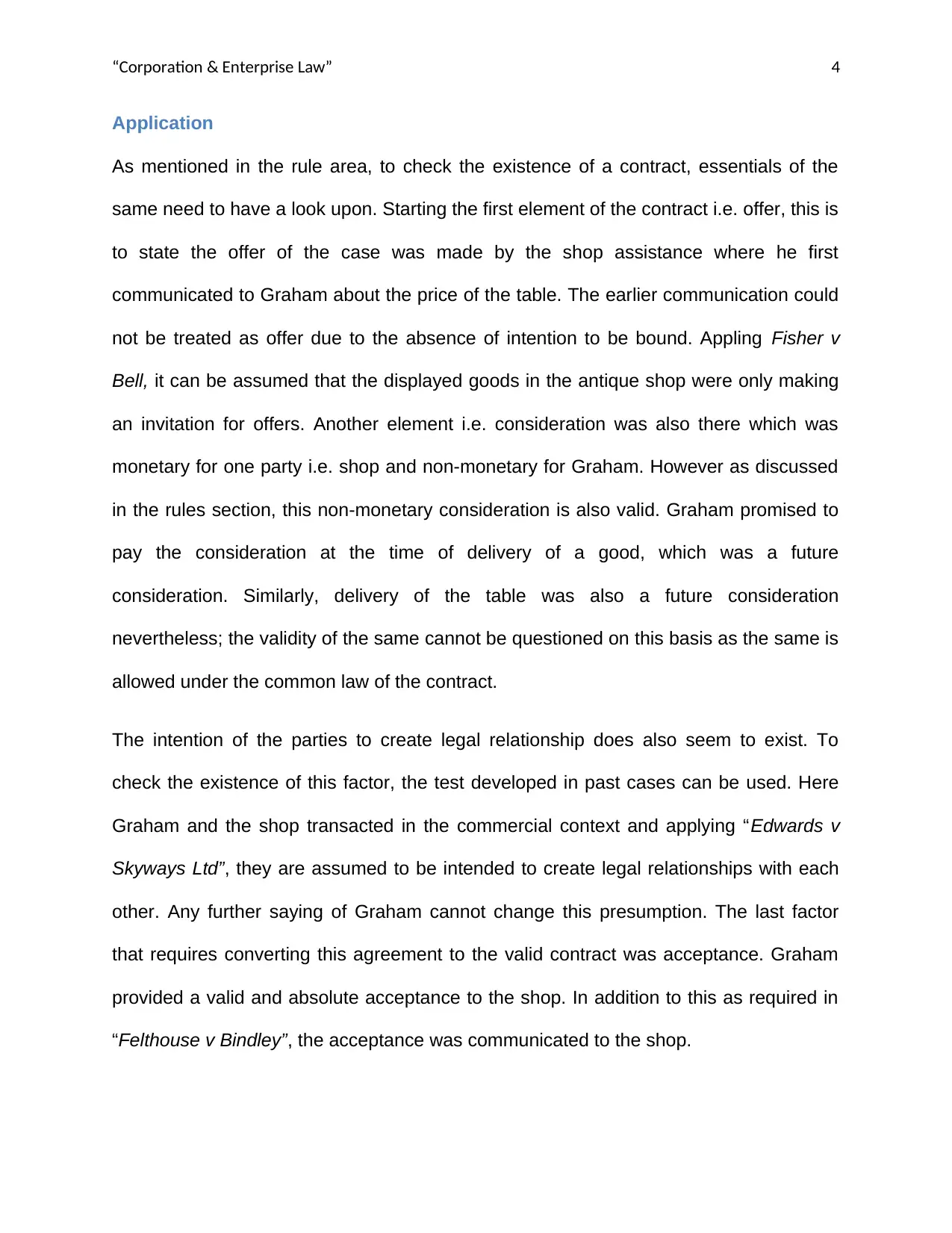
“Corporation & Enterprise Law” 4
Application
As mentioned in the rule area, to check the existence of a contract, essentials of the
same need to have a look upon. Starting the first element of the contract i.e. offer, this is
to state the offer of the case was made by the shop assistance where he first
communicated to Graham about the price of the table. The earlier communication could
not be treated as offer due to the absence of intention to be bound. Appling Fisher v
Bell, it can be assumed that the displayed goods in the antique shop were only making
an invitation for offers. Another element i.e. consideration was also there which was
monetary for one party i.e. shop and non-monetary for Graham. However as discussed
in the rules section, this non-monetary consideration is also valid. Graham promised to
pay the consideration at the time of delivery of a good, which was a future
consideration. Similarly, delivery of the table was also a future consideration
nevertheless; the validity of the same cannot be questioned on this basis as the same is
allowed under the common law of the contract.
The intention of the parties to create legal relationship does also seem to exist. To
check the existence of this factor, the test developed in past cases can be used. Here
Graham and the shop transacted in the commercial context and applying “Edwards v
Skyways Ltd”, they are assumed to be intended to create legal relationships with each
other. Any further saying of Graham cannot change this presumption. The last factor
that requires converting this agreement to the valid contract was acceptance. Graham
provided a valid and absolute acceptance to the shop. In addition to this as required in
“Felthouse v Bindley”, the acceptance was communicated to the shop.
Application
As mentioned in the rule area, to check the existence of a contract, essentials of the
same need to have a look upon. Starting the first element of the contract i.e. offer, this is
to state the offer of the case was made by the shop assistance where he first
communicated to Graham about the price of the table. The earlier communication could
not be treated as offer due to the absence of intention to be bound. Appling Fisher v
Bell, it can be assumed that the displayed goods in the antique shop were only making
an invitation for offers. Another element i.e. consideration was also there which was
monetary for one party i.e. shop and non-monetary for Graham. However as discussed
in the rules section, this non-monetary consideration is also valid. Graham promised to
pay the consideration at the time of delivery of a good, which was a future
consideration. Similarly, delivery of the table was also a future consideration
nevertheless; the validity of the same cannot be questioned on this basis as the same is
allowed under the common law of the contract.
The intention of the parties to create legal relationship does also seem to exist. To
check the existence of this factor, the test developed in past cases can be used. Here
Graham and the shop transacted in the commercial context and applying “Edwards v
Skyways Ltd”, they are assumed to be intended to create legal relationships with each
other. Any further saying of Graham cannot change this presumption. The last factor
that requires converting this agreement to the valid contract was acceptance. Graham
provided a valid and absolute acceptance to the shop. In addition to this as required in
“Felthouse v Bindley”, the acceptance was communicated to the shop.
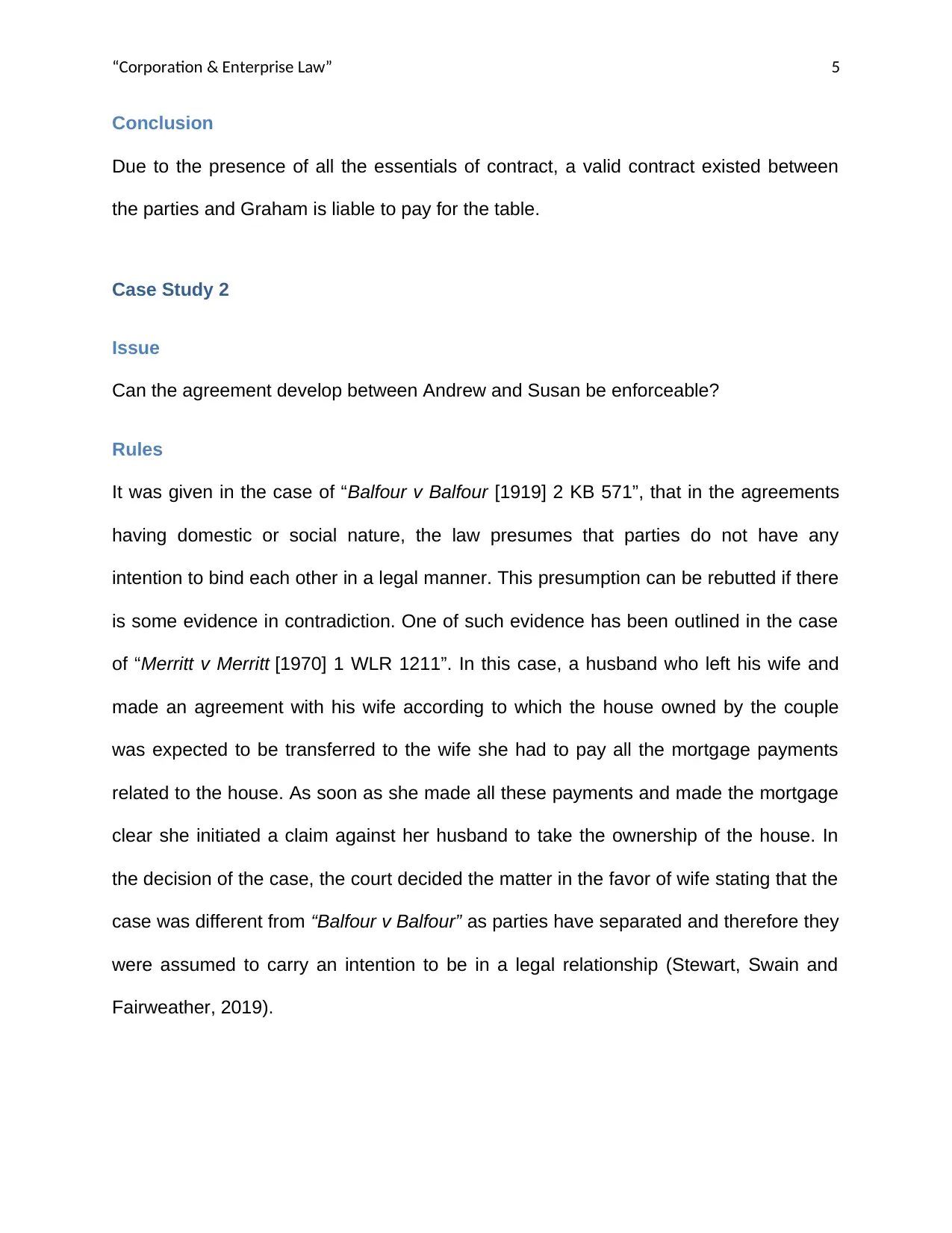
“Corporation & Enterprise Law” 5
Conclusion
Due to the presence of all the essentials of contract, a valid contract existed between
the parties and Graham is liable to pay for the table.
Case Study 2
Issue
Can the agreement develop between Andrew and Susan be enforceable?
Rules
It was given in the case of “Balfour v Balfour [1919] 2 KB 571”, that in the agreements
having domestic or social nature, the law presumes that parties do not have any
intention to bind each other in a legal manner. This presumption can be rebutted if there
is some evidence in contradiction. One of such evidence has been outlined in the case
of “Merritt v Merritt [1970] 1 WLR 1211”. In this case, a husband who left his wife and
made an agreement with his wife according to which the house owned by the couple
was expected to be transferred to the wife she had to pay all the mortgage payments
related to the house. As soon as she made all these payments and made the mortgage
clear she initiated a claim against her husband to take the ownership of the house. In
the decision of the case, the court decided the matter in the favor of wife stating that the
case was different from “Balfour v Balfour” as parties have separated and therefore they
were assumed to carry an intention to be in a legal relationship (Stewart, Swain and
Fairweather, 2019).
Conclusion
Due to the presence of all the essentials of contract, a valid contract existed between
the parties and Graham is liable to pay for the table.
Case Study 2
Issue
Can the agreement develop between Andrew and Susan be enforceable?
Rules
It was given in the case of “Balfour v Balfour [1919] 2 KB 571”, that in the agreements
having domestic or social nature, the law presumes that parties do not have any
intention to bind each other in a legal manner. This presumption can be rebutted if there
is some evidence in contradiction. One of such evidence has been outlined in the case
of “Merritt v Merritt [1970] 1 WLR 1211”. In this case, a husband who left his wife and
made an agreement with his wife according to which the house owned by the couple
was expected to be transferred to the wife she had to pay all the mortgage payments
related to the house. As soon as she made all these payments and made the mortgage
clear she initiated a claim against her husband to take the ownership of the house. In
the decision of the case, the court decided the matter in the favor of wife stating that the
case was different from “Balfour v Balfour” as parties have separated and therefore they
were assumed to carry an intention to be in a legal relationship (Stewart, Swain and
Fairweather, 2019).
⊘ This is a preview!⊘
Do you want full access?
Subscribe today to unlock all pages.

Trusted by 1+ million students worldwide
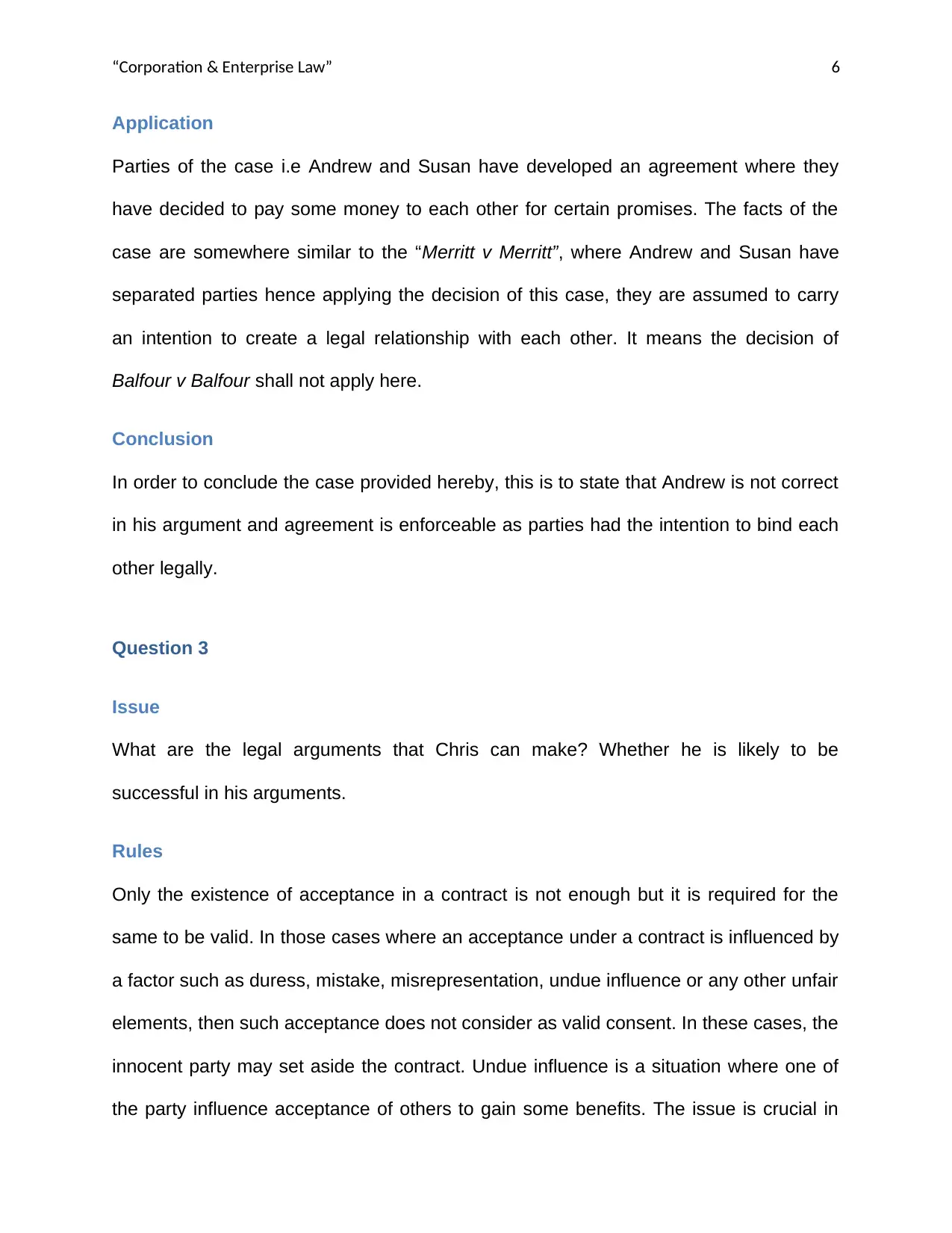
“Corporation & Enterprise Law” 6
Application
Parties of the case i.e Andrew and Susan have developed an agreement where they
have decided to pay some money to each other for certain promises. The facts of the
case are somewhere similar to the “Merritt v Merritt”, where Andrew and Susan have
separated parties hence applying the decision of this case, they are assumed to carry
an intention to create a legal relationship with each other. It means the decision of
Balfour v Balfour shall not apply here.
Conclusion
In order to conclude the case provided hereby, this is to state that Andrew is not correct
in his argument and agreement is enforceable as parties had the intention to bind each
other legally.
Question 3
Issue
What are the legal arguments that Chris can make? Whether he is likely to be
successful in his arguments.
Rules
Only the existence of acceptance in a contract is not enough but it is required for the
same to be valid. In those cases where an acceptance under a contract is influenced by
a factor such as duress, mistake, misrepresentation, undue influence or any other unfair
elements, then such acceptance does not consider as valid consent. In these cases, the
innocent party may set aside the contract. Undue influence is a situation where one of
the party influence acceptance of others to gain some benefits. The issue is crucial in
Application
Parties of the case i.e Andrew and Susan have developed an agreement where they
have decided to pay some money to each other for certain promises. The facts of the
case are somewhere similar to the “Merritt v Merritt”, where Andrew and Susan have
separated parties hence applying the decision of this case, they are assumed to carry
an intention to create a legal relationship with each other. It means the decision of
Balfour v Balfour shall not apply here.
Conclusion
In order to conclude the case provided hereby, this is to state that Andrew is not correct
in his argument and agreement is enforceable as parties had the intention to bind each
other legally.
Question 3
Issue
What are the legal arguments that Chris can make? Whether he is likely to be
successful in his arguments.
Rules
Only the existence of acceptance in a contract is not enough but it is required for the
same to be valid. In those cases where an acceptance under a contract is influenced by
a factor such as duress, mistake, misrepresentation, undue influence or any other unfair
elements, then such acceptance does not consider as valid consent. In these cases, the
innocent party may set aside the contract. Undue influence is a situation where one of
the party influence acceptance of others to gain some benefits. The issue is crucial in
Paraphrase This Document
Need a fresh take? Get an instant paraphrase of this document with our AI Paraphraser
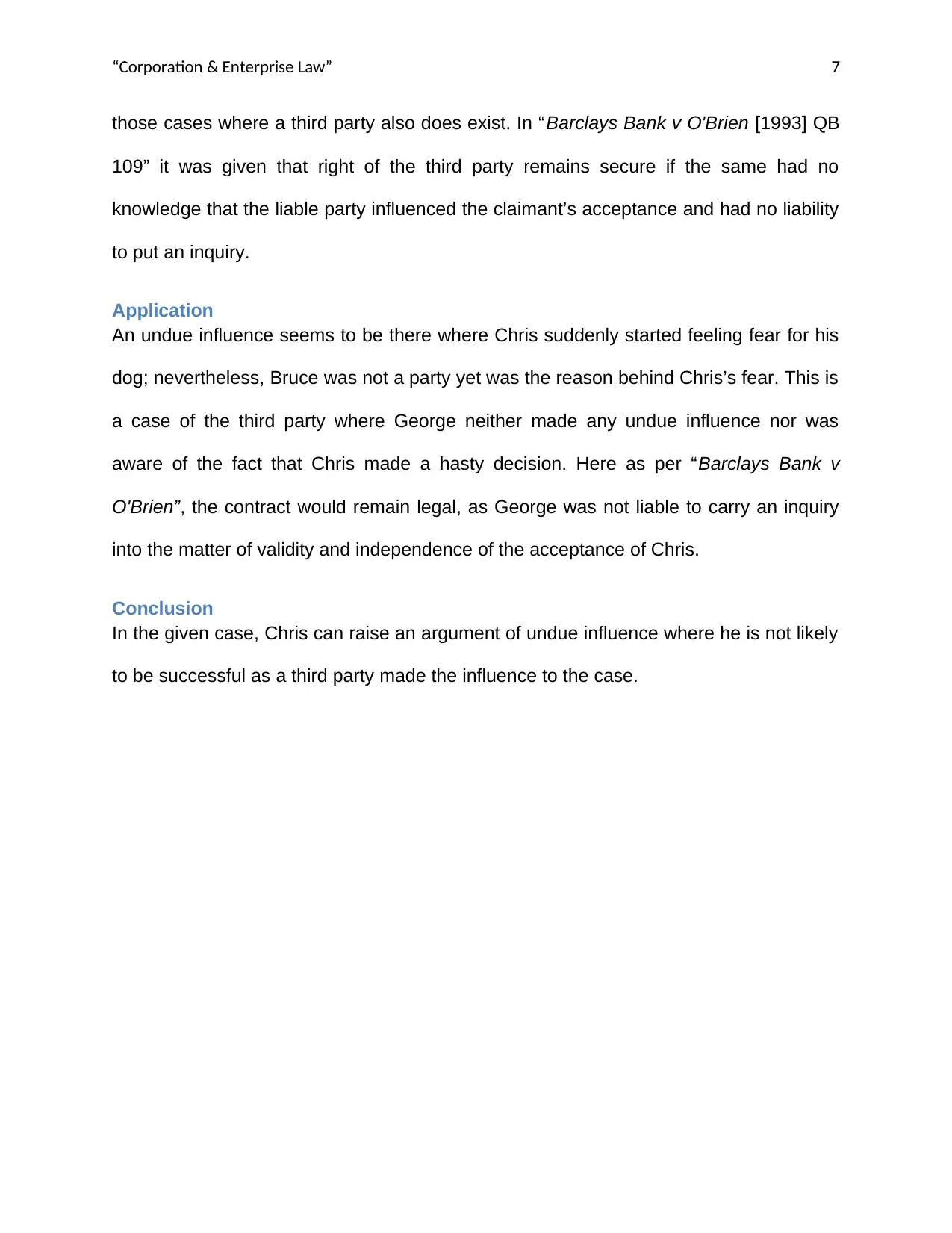
“Corporation & Enterprise Law” 7
those cases where a third party also does exist. In “Barclays Bank v O'Brien [1993] QB
109” it was given that right of the third party remains secure if the same had no
knowledge that the liable party influenced the claimant’s acceptance and had no liability
to put an inquiry.
Application
An undue influence seems to be there where Chris suddenly started feeling fear for his
dog; nevertheless, Bruce was not a party yet was the reason behind Chris’s fear. This is
a case of the third party where George neither made any undue influence nor was
aware of the fact that Chris made a hasty decision. Here as per “Barclays Bank v
O'Brien”, the contract would remain legal, as George was not liable to carry an inquiry
into the matter of validity and independence of the acceptance of Chris.
Conclusion
In the given case, Chris can raise an argument of undue influence where he is not likely
to be successful as a third party made the influence to the case.
those cases where a third party also does exist. In “Barclays Bank v O'Brien [1993] QB
109” it was given that right of the third party remains secure if the same had no
knowledge that the liable party influenced the claimant’s acceptance and had no liability
to put an inquiry.
Application
An undue influence seems to be there where Chris suddenly started feeling fear for his
dog; nevertheless, Bruce was not a party yet was the reason behind Chris’s fear. This is
a case of the third party where George neither made any undue influence nor was
aware of the fact that Chris made a hasty decision. Here as per “Barclays Bank v
O'Brien”, the contract would remain legal, as George was not liable to carry an inquiry
into the matter of validity and independence of the acceptance of Chris.
Conclusion
In the given case, Chris can raise an argument of undue influence where he is not likely
to be successful as a third party made the influence to the case.

“Corporation & Enterprise Law” 8
References
Balfour v Balfour [1919] 2 KB 571
Barclays Bank v O'Brien [1993] QB 109
Edwards v Skyways Ltd [1964] 1 WLR 349
Fisher v Bell [1961] 1 QB 394
lawcasesummaries.com. (2020) Fisher v Bell [1961] QB 394. [online] Available from:
https://lawcasesummaries.com/knowledge-base/fisher-v-bell-1961-qb-394/ [Accessed
on 09/04/2020]
Marson, J. (2013) Business Law. UK: OUP Oxford.
McKendrick, E., and Liu, Q. (2015) Contract Law: Australian Edition. UK: Macmillan
International Higher Education.
Merritt v Merritt [1970] 1 WLR 1211
Re McArdle (1951) Ch 669
Stewart, A., Swain, W., and Fairweather, K. (2019) Contract Law: Principles and
Context. UK: Cambridge University Press.
upcounsel.com. (2020) What is an Offer in Law Of Contract: Everything You Need to
Know. [online] Available from: https://www.upcounsel.com/what-is-an-offer-in-law-of-
contract [Accessed on 09/04/2020]
References
Balfour v Balfour [1919] 2 KB 571
Barclays Bank v O'Brien [1993] QB 109
Edwards v Skyways Ltd [1964] 1 WLR 349
Fisher v Bell [1961] 1 QB 394
lawcasesummaries.com. (2020) Fisher v Bell [1961] QB 394. [online] Available from:
https://lawcasesummaries.com/knowledge-base/fisher-v-bell-1961-qb-394/ [Accessed
on 09/04/2020]
Marson, J. (2013) Business Law. UK: OUP Oxford.
McKendrick, E., and Liu, Q. (2015) Contract Law: Australian Edition. UK: Macmillan
International Higher Education.
Merritt v Merritt [1970] 1 WLR 1211
Re McArdle (1951) Ch 669
Stewart, A., Swain, W., and Fairweather, K. (2019) Contract Law: Principles and
Context. UK: Cambridge University Press.
upcounsel.com. (2020) What is an Offer in Law Of Contract: Everything You Need to
Know. [online] Available from: https://www.upcounsel.com/what-is-an-offer-in-law-of-
contract [Accessed on 09/04/2020]
⊘ This is a preview!⊘
Do you want full access?
Subscribe today to unlock all pages.

Trusted by 1+ million students worldwide
1 out of 9
Related Documents
Your All-in-One AI-Powered Toolkit for Academic Success.
+13062052269
info@desklib.com
Available 24*7 on WhatsApp / Email
![[object Object]](/_next/static/media/star-bottom.7253800d.svg)
Unlock your academic potential
Copyright © 2020–2025 A2Z Services. All Rights Reserved. Developed and managed by ZUCOL.




